Stone cavities and space continuity.
The bathroom environment according to Manuel Aires Mateus
December 27, 2012
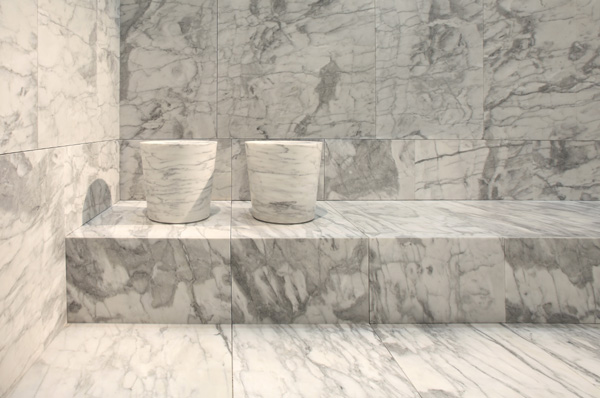
Manuel Aires Mateus, marble bathroom, 2012
“An object, unless it’s exceptional, can’t be an absolute protagonist; it should express a great measure, that is to say show a willingness to establish connections. (…) Fittings that have made history own a noticeable measure and a kind of triviality, this being an ambiguous word that I use not meaning “lacking of interest or quality”, but “disposable to continuity”. (…) Design implies strong contacts with manufacturing and industrial production. In order to take all their potentialities it is necessary to understand which these potentialities are. During the productive process (…) it is necessary to create a strict link between the project and who is carrying it out.”i
These concepts expressed by Alvaro Siza in this general dissertation about design are very appropriate to describe Manuel Aires Mateus’s latest integrated project for the bathroom environment.
Manuel, protagonist with his brother Francisco of one of the most significant professional experiences in contemporary Portuguese architecture, studied a new collection of technical elements in natural stone that seems to embody the idea of “measure” identified by Siza as “willingness to establish connections”; the collection, named Escavo, was developed in collaboration with the leading stone brand Pibamarmi, in direct contact with the productive process.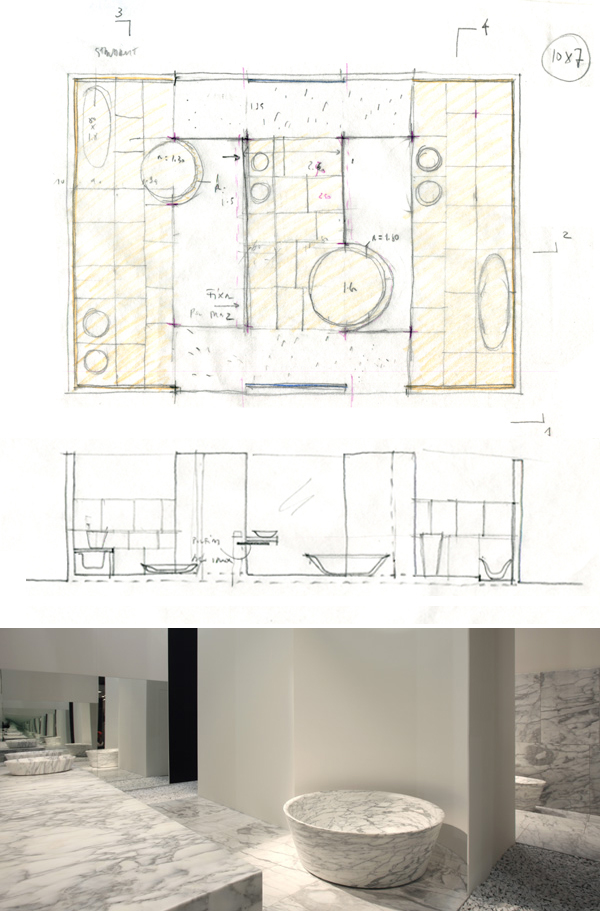
Manuel Aires Mateus, marble bathroom at 2012 Salone Internazionale del Bagno. Projecting sketches and general view
Very often Manuel and Francisco Aires Mateus enrich the presentation of their projects with photos of quarries or rock scenarios, and from that it can be easily understood the high value given by the architects not to the mass itself, in its entirety, but to the eroded and dug solid form and to the void the consequently is originated.ii
As these strongly evocative photos underline once more, the cavity – or better, the mass at its negative – is a recurring study theme in the architectures by the Portuguese brothers and recently has been developed by Manuel on the scale of the project design in creating a collection of pieces for the bathroom furnishing made of natural stone. The Escavo collection is characterized by a simple, pragmatic, conceptually immediate design, including archetypical shapes of water holders as buckets, tubs, and bowls. They are elementary objects, rudimentary in some sense, but yet becoming refined as the subtle and curved lines of some porcelain vases or crockery.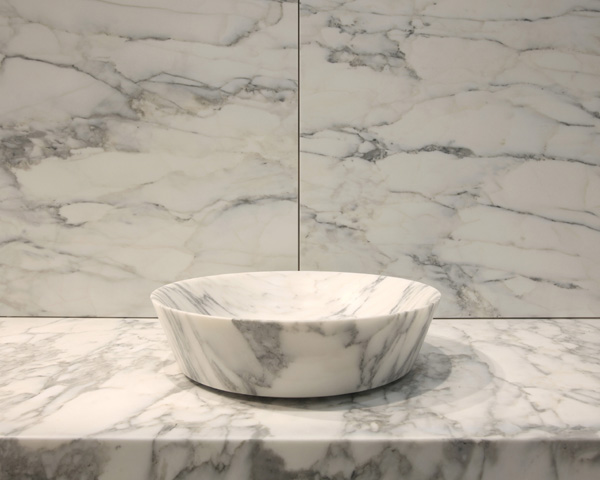
Manuel Aires Mateus, Bacìa basin, Escavo Collection, 2012 (production Pibamarmi).
Aires Mateus’ project design is indeed concentrated on the contrast between essentiality of mass and complexity of void, on the identification of nonaligned negative volumes, designed according to a continuous and sinuous line, de-materializing monoliths in the shape of truncated cones or parallelepipeds; near the borders the so-obtained cavities follow a flexible and sharp movement, inspired by the shapes of the Oriental china, ancient yet extremely elegant and accurate in their material consistence and in the details of their borders.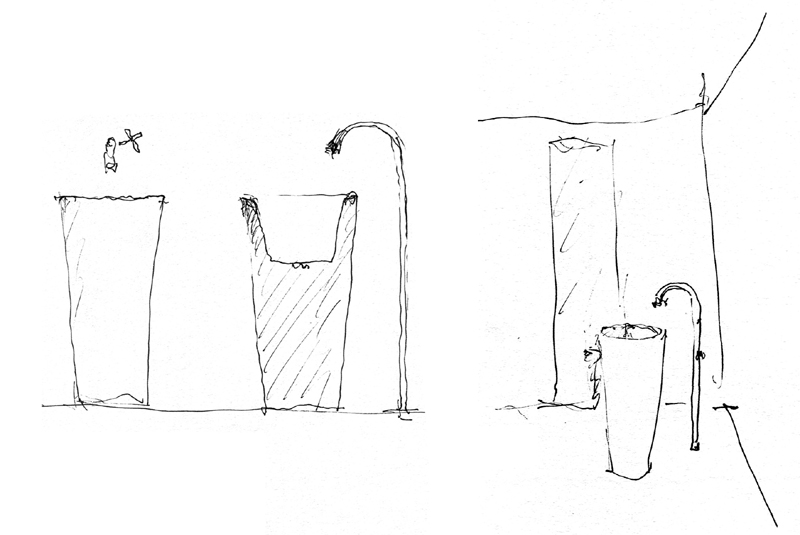
Manuel Aires Mateus, sketches for stone basins and bathrooms, march 2011
In this first experience as a designer, Manuel Aires Mateus keeps re-elaborating the cavities in his formal world: they take shape as plastic masses or as hollow volumes obtained through a process of removal of the material, in this case even more explicit because expressed in a mono-material context uniquely dominated by the presence of stone.iii
The cavities of the elements, thanks to their particular section, play with light in a series of penumbras and shades that become more and more intense, starting from the edge to the curved and tensed bottom; the Portuguese architect’s project faces the complexity of characteristics involved in designing the void, its diverse morphologies and dimensions, its lighting conditions and, above all, the dynamics through which the visitors experience it.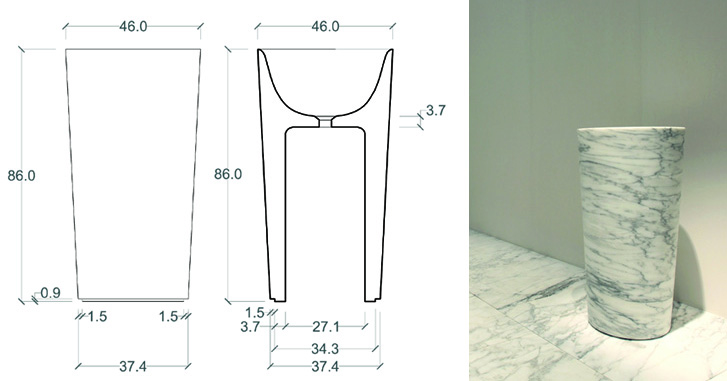
Manuel Aires Mateus, Balde basin, Escavo Collection, 2012 (production Pibamarmi)
From the series of technical elements for the bathroom, according to Aires Mateus, product design perfectly integrates with interior design, reaching a concept of total design of the body care environment: the overall value of the projecting action is once again in the enclosure, in the spatial enucleation, in the indication of a precise domain defined by wall surfaces in which the objects are collocated in interaction with the void and the walls delimitating it. More than ever basins, tubs and shower plates aren’t protagonists unrelated to the context, but are co-protagonists leant against the walls, or partially included in them, or even built into the floors, partially revealed, partially hidden by the stone casing of the room.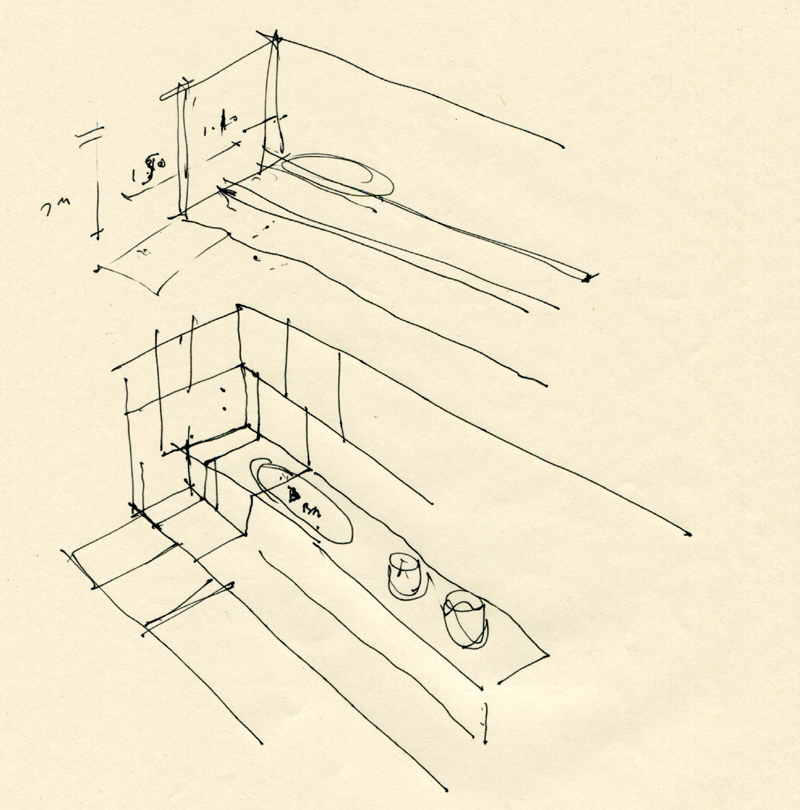
Manuel Aires Mateus, sketches for stone bathrooms, January 2012
Carefully analysing this project, it is clear the complete assimilation and reworking by Manuel of Adolf Loos’s interior architecture, filtered with the works by Alvarzo Siza. In particular the objects and the spaces for the bathroom show evident associations with Siza’s rooms and design elements in marble, as the interiors of Borges Bank in Irmao (1969), Avelino Duarte’s house in Over (1980-84), or the liturgic fittings (altar, chair, font) for Santa Maria church in Marco Canavezes (1990-96), veritable relational objects with straight elementary volumes cut ouf of natural stone.
In Siza’s interiors, and the same is for Goncalo Byrne’s iv(the Mateus brothers took the first steps as designers in his studio), the lavish marble coverings of the house typical of Loos, articulated in columns, boiseries, frames, steps, floors and fixed fittings, are re-proposed to create totalizing stone walls, strong enough to transmit the idea of a uninterrupted space continuity.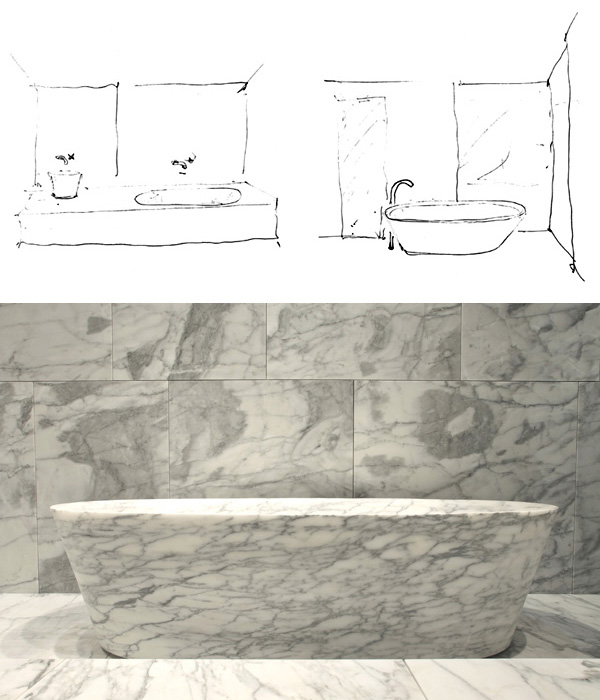
Manuel Aires Mateus, sketches of stone bathrooms and the marble tub Banheira of the Escavo collection, 2012
In this idea of interconnected bathroom, made of stone objects and surfaces, recurring dimensional modules characterize basins, shower trays, covering tiles horizontally and vertically distributed. These modules are aimed to assure maximum flexibility in order to cover with continuity different kind of surfaces. As usual for forms dug out of stone, the edges and the walls of the bathroom fittings are full and straight, but never too thick, the monolithic volumes are well proportioned, the finishing of the stone surfaces is smooth, silken and soft to touch.
Every technical element, autonomously or in couple, can find the right collocation in an existing bathroom, every piece of the collection – rigorous and essential in itself – has a precise function in an archipelago of technical object that can be re-distributed in multiple configurations without need of expressly re-dimension the space. Manuel Aires Mateus’s objects and rooms are conceived to create new formal and functional archetypes, able to authentically and directly interact with the users because of their “willingness to relations and continuity”.
back to top print
Post-it
ISSN 2239-6063
edited by
Alfonso Acocella
redazione materialdesign@unife.it